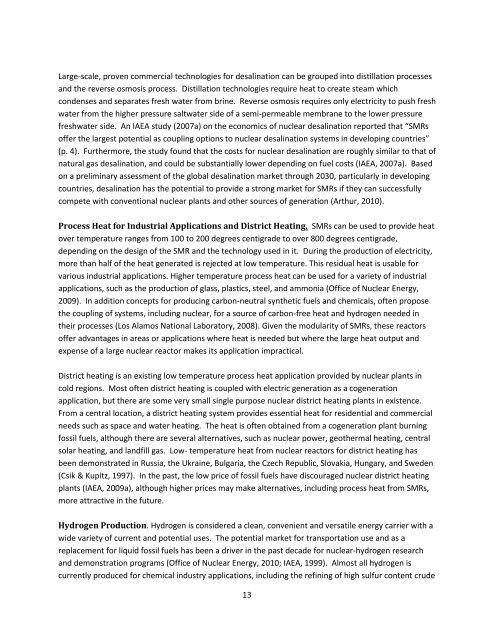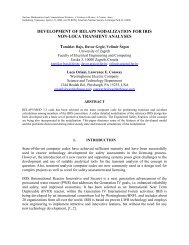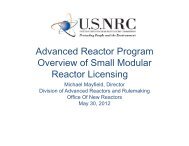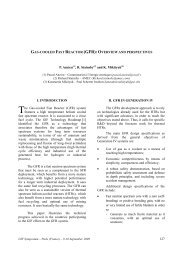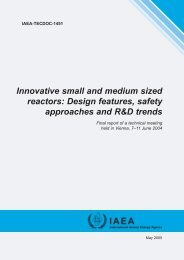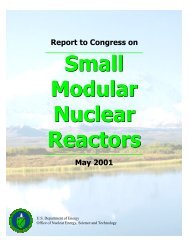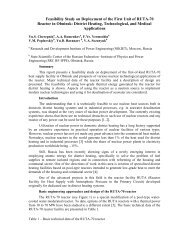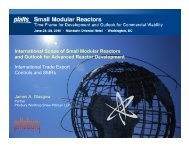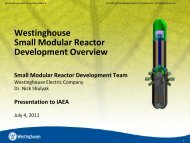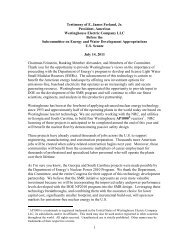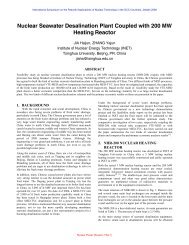Economic and Employment Impacts of Small Modular Reactors - SMR
Economic and Employment Impacts of Small Modular Reactors - SMR
Economic and Employment Impacts of Small Modular Reactors - SMR
- No tags were found...
Create successful ePaper yourself
Turn your PDF publications into a flip-book with our unique Google optimized e-Paper software.
Large-‐scale, proven commercial technologies for desalination can be grouped into distillation processes<br />
<strong>and</strong> the reverse osmosis process. Distillation technologies require heat to create steam which<br />
condenses <strong>and</strong> separates fresh water from brine. Reverse osmosis requires only electricity to push fresh<br />
water from the higher pressure saltwater side <strong>of</strong> a semi-‐permeable membrane to the lower pressure<br />
freshwater side. An IAEA study (2007a) on the economics <strong>of</strong> nuclear desalination reported that <strong>SMR</strong>s<br />
<strong>of</strong>fer the largest potential as coupling options to nuclear desalination systems in developing countries<br />
(p. 4). Furthermore, the study found that the costs for nuclear desalination are roughly similar to that <strong>of</strong><br />
natural gas desalination, <strong>and</strong> could be substantially lower depending on fuel costs (IAEA, 2007a). Based<br />
on a preliminary assessment <strong>of</strong> the global desalination market through 2030, particularly in developing<br />
countries, desalination has the potential to provide a strong market for <strong>SMR</strong>s if they can successfully<br />
compete with conventional nuclear plants <strong>and</strong> other sources <strong>of</strong> generation (Arthur, 2010).<br />
Process Heat for Industrial Applications <strong>and</strong> District Heating. <strong>SMR</strong>s can be used to provide heat<br />
over temperature ranges from 100 to 200 degrees centigrade to over 800 degrees centigrade,<br />
depending on the design <strong>of</strong> the <strong>SMR</strong> <strong>and</strong> the technology used in it. During the production <strong>of</strong> electricity,<br />
more than half <strong>of</strong> the heat generated is rejected at low temperature. This residual heat is usable for<br />
various industrial applications. Higher temperature process heat can be used for a variety <strong>of</strong> industrial<br />
applications, such as the production <strong>of</strong> glass, plastics, steel, <strong>and</strong> ammonia (Office <strong>of</strong> Nuclear Energy,<br />
2009). In addition concepts for producing carbon-‐neutral synthetic fuels <strong>and</strong> chemicals, <strong>of</strong>ten propose<br />
the coupling <strong>of</strong> systems, including nuclear, for a source <strong>of</strong> carbon-‐free heat <strong>and</strong> hydrogen needed in<br />
their processes (Los Alamos National Laboratory, 2008). Given the modularity <strong>of</strong> <strong>SMR</strong>s, these reactors<br />
<strong>of</strong>fer advantages in areas or applications where heat is needed but where the large heat output <strong>and</strong><br />
expense <strong>of</strong> a large nuclear reactor makes its application impractical.<br />
District heating is an existing low temperature process heat application provided by nuclear plants in<br />
cold regions. Most <strong>of</strong>ten district heating is coupled with electric generation as a cogeneration<br />
application, but there are some very small single purpose nuclear district heating plants in existence.<br />
From a central location, a district heating system provides essential heat for residential <strong>and</strong> commercial<br />
needs such as space <strong>and</strong> water heating. The heat is <strong>of</strong>ten obtained from a cogeneration plant burning<br />
fossil fuels, although there are several alternatives, such as nuclear power, geothermal heating, central<br />
solar heating, <strong>and</strong> l<strong>and</strong>fill gas. Low-‐ temperature heat from nuclear reactors for district heating has<br />
been demonstrated in Russia, the Ukraine, Bulgaria, the Czech Republic, Slovakia, Hungary, <strong>and</strong> Sweden<br />
(Csik & Kupitz, 1997). In the past, the low price <strong>of</strong> fossil fuels have discouraged nuclear district heating<br />
plants (IAEA, 2009a), although higher prices may make alternatives, including process heat from <strong>SMR</strong>s,<br />
more attractive in the future.<br />
Hydrogen Production. Hydrogen is considered a clean, convenient <strong>and</strong> versatile energy carrier with a<br />
wide variety <strong>of</strong> current <strong>and</strong> potential uses. The potential market for transportation use <strong>and</strong> as a<br />
replacement for liquid fossil fuels has been a driver in the past decade for nuclear-‐hydrogen research<br />
<strong>and</strong> demonstration programs (Office <strong>of</strong> Nuclear Energy, 2010; IAEA, 1999). Almost all hydrogen is<br />
currently produced for chemical industry applications, including the refining <strong>of</strong> high sulfur content crude<br />
13


